When I travel overseas and need to pack light, I often take my Leica M2 rangefinder camera with compact 35mm and 50mm f/2.0 Summicron lenses (along with light meter, filters, and hoods). But recently, I have been thinking wide, which must go along with my increasing girth. Some options:
- New Leica 24mm f/1.4 Summilux-M lens. $7500 in USA. (Ouch, pain)
- Used (OK, “pre-owned”) Leica 24mm f/2.8 lens. About $1800. (Lesser pain)
- Used Zeiss Biogon 25 mm f/2.8 ZM lens. About $750 in USA.
- New Voigtlander Skopar 24mm f/4.0 lens. About $400
Of course the genuine 24mm M lens or the 25mm Zeiss would be best, but realistically I would not use them all that often.
Temporary Solution
We have a clean Super-Multi-Coated Takumar 24mm f/3.5 lens for the Pentax Spotmatic in the cabinet. It performs quite well on the Spotmatic. Because it has a longer register distance to the mount than true M lenses, there is room for an adapter. So I bought a $20 Fotodiox M42-Leica M adapter from Amazon and did a test run. The Chinese specialty companies make adapters for just about any older manual SLR lens to fit most so-called mirrorless digital camera bodies, giving new life to many beautiful classic film lenses. Most longer focal lengths, around 50mm or more, perform really well on digital bodies. The wide angles often have problems with digital sensors, but in that I was using film, I was going to use a lens designed for film on the correct sensing media.
Results
The good: The optical results were better than I expected. I do not have a genuine Leica 24mm, so I have no basis for comparison. Sure, it is not as “sharp” as my 35 Summicron, but so what? Sharpness phobia is nonsense that consumes pseudo-photographers on digital camera web pages. For $20, I am pleased.
The clumsy: Framing is a problem. If I move my eye left and right and up and down the maximum extent across the M2’s eyepiece, I think I see most of the 24mm coverage. The lens blocks part of the view, and using the genuine Takumar hood is hopeless. To do: buy a 24mm finder. Focus is totally manual.
The heavy: The Takumar with its Fotodiox adapter is a bulky and rather heavy cylinder.
Here are some examples from Romania and Greece. The film was Fujifilm Acros, exposed at EI=80. Praus Productions in Rochester, NY, developed the film in Xtol. I scanned the film with a Plustek 7600i scanner using the Tri-X 400 profile (the SilverFast software does not have an Acros profile), saving as 16-bit monochrome TIFF files. I cleaned occasional lint or chemical blobs with the heal tool in Photoshop CS3.
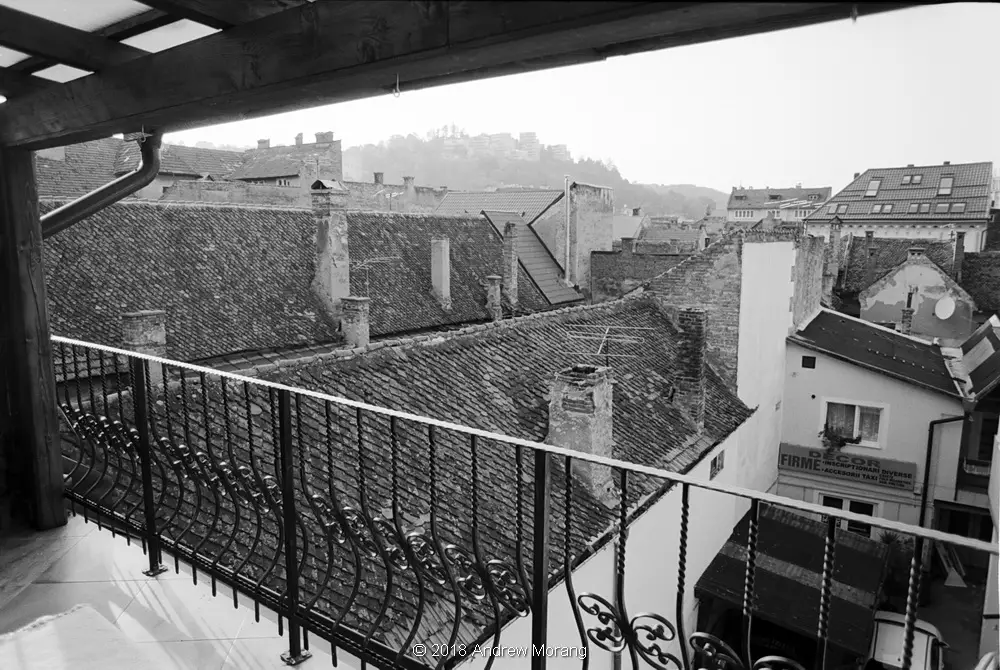
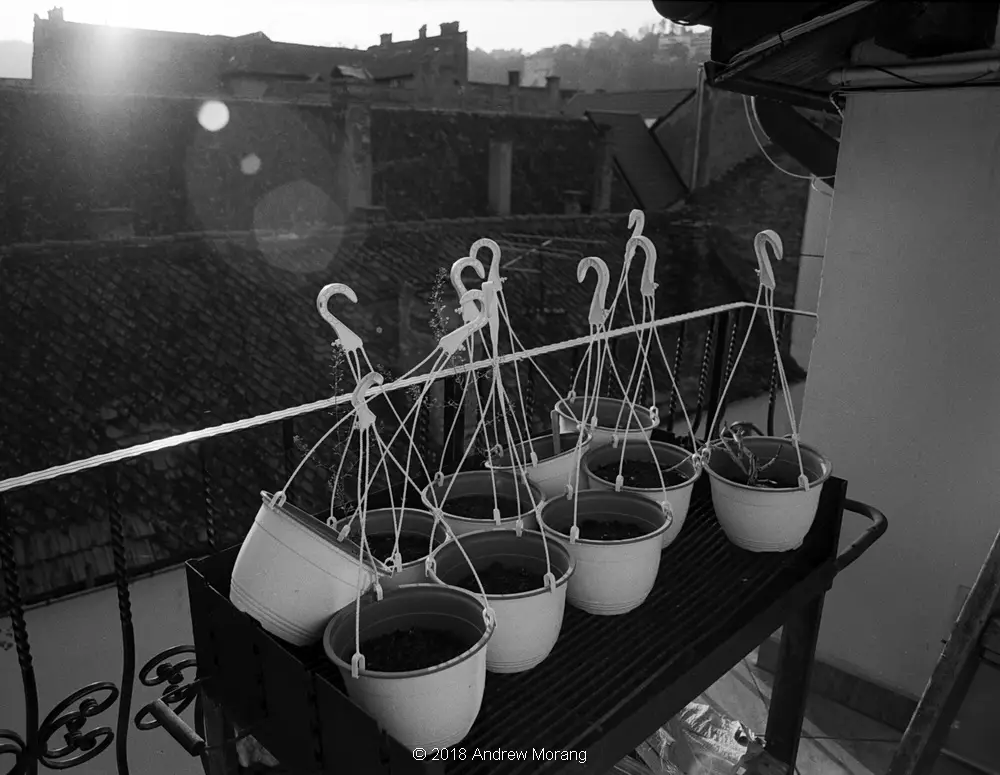
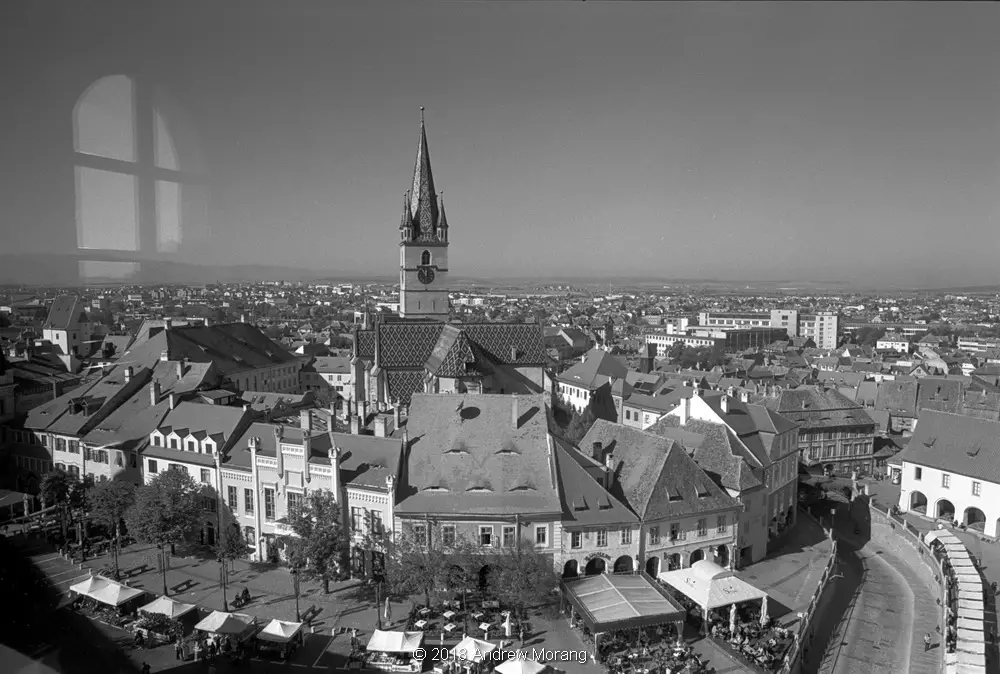
The view of the upper town and the Gothic tower of the Lutheran Cathedral of Saint Mary in Sibiu, Romania, is from the Council Tower. I used a yellow filter on the 24mm lens to darken the sky. The photograph is through glass, which you see in the upper left.
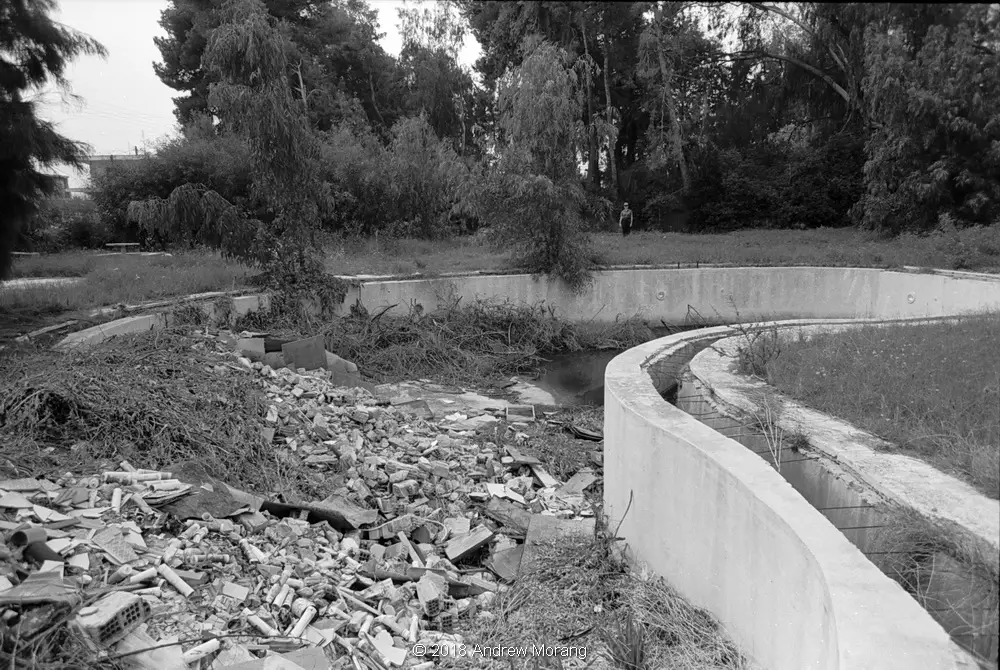
An abandoned hotel from the 1960s, possibly once called the Angela, is in Nerantza, Greece, a few km west of Corinth on the Gulf of Corinth. I have photographed here before with a digital camera, but the 24mm lens and black and white film gives an appropriate gloomy look to the remnants.
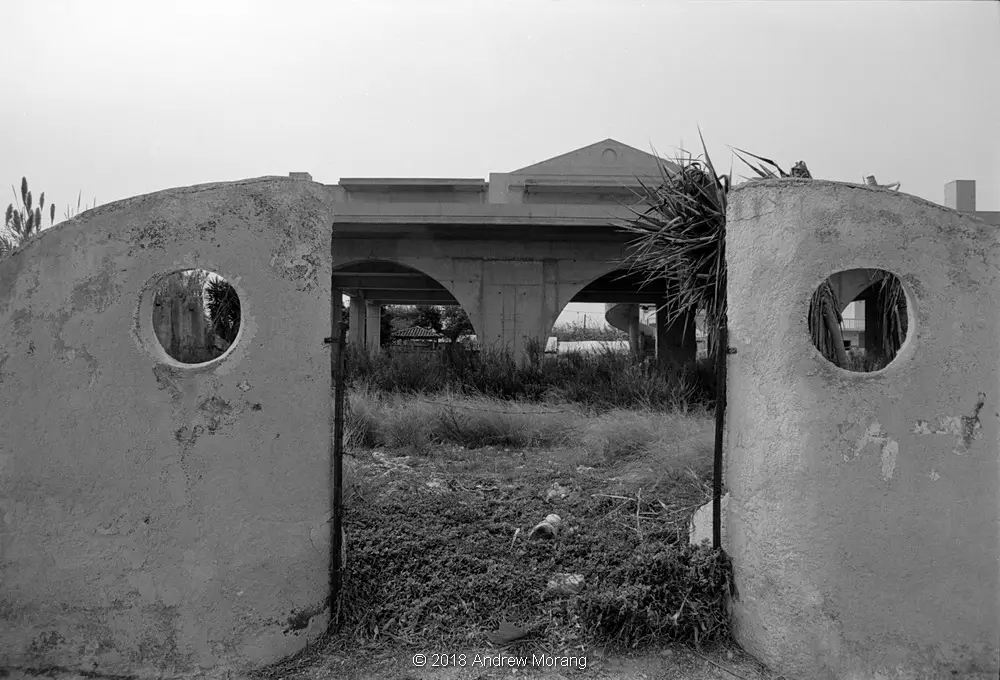
Conclusions
The 24mm Takumar lens works well on the Leica M2. Framing is clumsy and you need to guess the distance of your main subject, but that is not too critical with a wide angle lens. As I already had the 24mm lens, $20 for an adapter was a bargain way to get wide angle coverage. A 24mm auxiliary finder would be helpful. However, for an upcoming trip, I have rented a 25mm Zeiss ZM lens from LensRentals.com. It will be more compact and should not obscure much of the finder. Stand by for an upcoming “5 Frames” note.
Please see more urban decay at: https://worldofdecay.blogspot.com
Share this post:
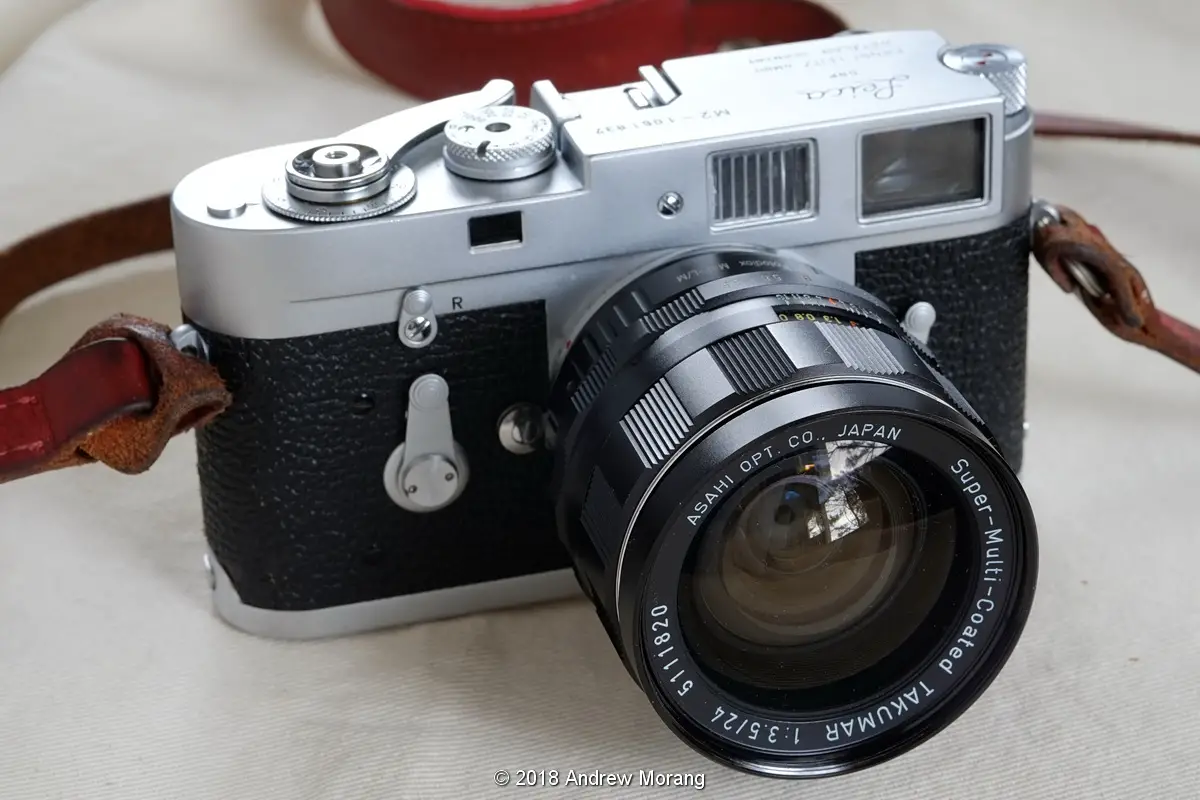








Comments
bydlo on Asahi Takumar 24mm Lens on a Leica M2 – by Andrew Morang
Comment posted: 04/01/2019
Comment posted: 04/01/2019
Comment posted: 04/01/2019
Comment posted: 04/01/2019
Anthony Oresteen on Asahi Takumar 24mm Lens on a Leica M2 – by Andrew Morang
Comment posted: 04/01/2019
Voigtlander did release a 25mm lens in Nikon S mount that is RF coupled. I bought one and it came with a 25mm optical finder. I use it on my Contax IIa body or my Nikon SP. Nice lens. Solves my 25mm RF lens itch. If you continue to want a 25mm RF lens get a Voigtlander.
In the early 80's I used Pentax Spotmatic & ES II cameras and the 24mm SMC Takumar was in my kit bag. It's small compared to the 20mm SMC Takumar. But not anywhere as small as a Voigtlander 25mm!
Barry Carr on Asahi Takumar 24mm Lens on a Leica M2 – by Andrew Morang
Comment posted: 04/01/2019
Nope. I regularly use an adapted Olympus 24mm f/2.8 on my Sony A7ii and have had no issue whatsosever with IQ. Its only extermely wide RF lenses that have issues with edge smearing on full-frame sensors and even then its not that noticable.
Rob Kent (jazzycamel) on Asahi Takumar 24mm Lens on a Leica M2 – by Andrew Morang
Comment posted: 04/01/2019
Comment posted: 04/01/2019
Terry B on Asahi Takumar 24mm Lens on a Leica M2 – by Andrew Morang
Comment posted: 04/01/2019
I have a multitude of adapters in Sony E mount, Fuji X, and Olympus m4/2 so I can use my myriad of legacy lenses inc. Leica R, M, Minolta MD, Olympus OM, and a few other, perhaps more esoteric mounts such as Contarex and Voigtlander DKL. The one thing I've learnt is that nearly all these adapters, bar 2 in Leica by a little known brand Ulata, never register the lens focused correctly at infinity when the lens is at infinity. This isn't a big problem as the lenses are being focused manually in digital cameras.
But how did you ensure this using a film camera?
Comment posted: 04/01/2019
Nick Lyle on Asahi Takumar 24mm Lens on a Leica M2 – by Andrew Morang
Comment posted: 04/01/2019
Steve Abbott on Asahi Takumar 24mm Lens on a Leica M2 – by Andrew Morang
Comment posted: 04/01/2019
I then paid about £13 for a Chinese made FD to M mount adaptor - which I could have had cheaper if I'd been prepared to wait a month for delivery from China, instead of about 10 days. This was a bit fiddly to mount the lens on (due to the nature of the FD mount, not the adaptor), but it doesn't matter as I don't plan to disassemble it again. Of course, the lens in this set-up is not rangefinder coupled - but with this focal length, everything's in focus at virtually all apertures, so who cares!
The key to success, however, is that I found on eBay a maker of viewfinders in Israel; he offers a variety of focal lengths, including 24mm, and I suspect that they're made in a similar way to that described in a post here on 35mmc - i.e. the cannabilised viewfinder from a dead point-and-shoot in a laser printed housing. It was only about £17 (although expensive shipping nearly doubled that), and frankly it's fairly terrible, inasmuch that the view is rather distorted in a "fisheye" type of way, but it nevertheless accurately shows the field of view and perspective - and I can keep my other eye open for a simultaneous clear view of the subject. In practise it works very well.
With the addition of a cheap M-mount rear cap, I paid just over £100 for the whole lot, which is a fraction of the cost of a 24mm viewfinder alone! Although it's a focal length I don't use a great deal (so why pay a lot of money?!), it's one that at times IMO is indispensable (architecture, streets, landscape if there's foreground interest) and I've been absolutely delighted with the results, having had a greater proportion of "keepers" than average. If you can get hold of one of these cheap and cheerful viewfinders, then I heartily recommend it.
Graham Line on Asahi Takumar 24mm Lens on a Leica M2 – by Andrew Morang
Comment posted: 04/01/2019
Daniel Castelli on Asahi Takumar 24mm Lens on a Leica M2 – by Andrew Morang
Comment posted: 04/01/2019
The work looks good, my favorite is "The view from upper town," I can help but to see 5 'eyes' on the building in the lower center of the frame...that shot would keep me up at night!
I'm a bit amused by your idea of traveling light. To me, your kit is anything but light, but if it worked for you and didn't present any problems with weight or physical bulk, good for you.
My wife & took a seven day vacation to Ireland last October. I carried a M4-P, light meter, film and a 28mm Ultron f/2.0 lens. I took a deep breath when packing, crossed my fingers and hoped I wouldn't regret packing more equipment. It worked out OK. A good pedestrian lens, and I didn't miss my other gear. Of course, nightly visits to pubs helped me not to worry.
Francesco Melis on Asahi Takumar 24mm Lens on a Leica M2 – by Andrew Morang
Comment posted: 05/01/2019